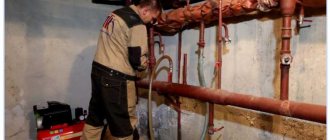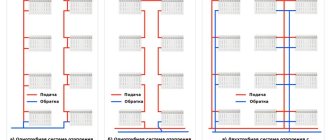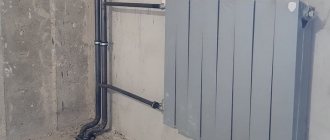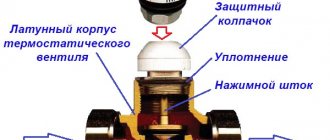In the process of heating a house or apartment, the coolant is pushed by the engine along the circuit. If it is not balanced, it will heat the rooms unevenly. For example, when the house has radiators and heated floors, one of the systems may warm up more than the other. To prevent this from happening, when installing a heating system, it is necessary that the heating system be balanced correctly.
Heating system diagram Source aw-therm.com.ua
The concept of balancing
For a heating system to operate as efficiently as possible, it is important that it releases heat in such a way that it warms all rooms evenly. This will not only provide warmth and comfort in the house, but will also help reduce heating costs.
Heating systems can be divided into two types:
- Single-pipe or double-pipe. In them, the heated coolant moves through pipes from the heating boiler, giving off some of the heat to each radiator. Then the liquid that has lost heat enters the boiler again. After this, the cycle described here is repeated again.
- System with manifold connection. It has a distribution device, from which pipes go separately to each radiator. The adjustment occurs for each of them independently.
The last category includes heating systems that use not only radiators, but also heated floors.
The general principle of balancing is similar in different cases. Each radiator has an inlet valve. If they are all fully deployed, then the greatest heat loss in the first category of systems will occur in the first device. Further, increasingly cooled water will flow. To prevent this from happening, a valve is tightened in the initial batteries. Thus, the heat consumption will decrease and it will be enough for other heating devices.
Two-pipe system with heated floors Source eurosantehnik.ru
This procedure must be done in several steps to achieve the desired result. Between attempts, the batteries are given time to warm up properly.
For heating systems, regulation occurs by regulating the volume of incoming heated liquid. There should be so much of it that it is enough to heat each room.
The floors are adjusted in the same way, increasing or decreasing the heat supply. If the floors use heating based on the use of electrical energy, adjustment is made according to different rules, simply changing the settings.
Flow regulators, bypass valves, control valves, and pressure regulators are used to carry out adjustments. The layout of their installation depends on the specific type of heating system.
Thermostats occupy a special place. They have the most complete functionality. The device contains an electronic temperature sensor. The work takes place under the control of an electronic circuit. There is a simple and intuitive control panel.
The use of such electronic devices allows adjustments to be made at minimal cost. If necessary, it is possible to program the heating operation. For example, it is possible to reduce the heating temperature if the family is absent from the house for several days.
Water heated floors Source teplyiypol.ru
Ball valve
This is the most famous type of shut-off valve. Inside it there is a smooth ball that has a through hole and is capable of rotating 90°C, thus regulating the flow of water in the pipe, closing or opening it. The design of the mechanism provides it with minimal resistance to flow when open. It is designed to operate in the fully open or fully closed position to quickly shut off the water or, in some cases, drain it. Intermediate provisions are possible, but prohibited.
The materials for these mechanisms will be nickel-plated brass and stainless steel; for metal-plastic systems, polymer materials are also used. There are expensive and high-quality cranes from the Danfoss, Giacomini, and Bugatti brands on the market. For limited financial capabilities, Chinese and Turkish Valtec and Fado are offered. Good quality at a low price is offered by the Chinese AGUA-WORID.
The most common type of tap is a valve. Allows you to regulate the pressure. The flow channel inside it is perpendicular to the flow of liquid in the supply pipes. Installation must be carried out with careful attention to the markings so that water flows only in one direction.
For heating systems there are valves with a conical valve. They are most effective for such conditions. Fully open, it allows the maximum amount of liquid to pass through, which makes the thermal output of the battery more efficient. The mechanism allows you to reduce the flow of coolant and reduce heat transfer if the room is too hot and, thus, control the temperature.
There are these types:
- adjusting (straight and angular). They have manual control. Used in autonomous heating. They cannot accurately adjust heat transfer due to the lack of a scale and temperature sensor;
- equipped with a thermal head. Their design allows the temperature rise to be blocked or limited through manual or automatic control. Installed on two- and one-pipe systems. Adjustment is simple - the required temperature is set manually using a limit ring;
- with thermostat. Installed in front of the battery. The flow of coolant is controlled by a tap mounted in front of the thermostat.
There are no valve taps made of plastic; they are made from brass, steel or a combination of these materials.
Adjustment methods
When balancing the heating system in a private home, you can use temperature readings or coolant flow data as a basis. Each of them has its pros and cons.
First way
The installation implies that all necessary calculations for coolant flow have been previously carried out for the project. It is necessary not only to have control valves, but also measuring devices. Here it is possible to control the volume of coolant pumped through the system and make the necessary settings if necessary.
The advantage of using this method is the high quality of heat control in various rooms. The disadvantage of this approach is the relatively high cost of installing such a system.
Heat distribution in a room Source thebridgestudio.ru
Second way
It is suitable in situations where no preliminary calculations were made when installing the heating system. Then the heating system is adjusted as follows. In such cases, thermometer readings are used for adjustment. At the same time, they try to make the heat consumption approximately equal for each radiator. If the battery is installed in a large room, then it is adjusted so that the heating is proportionally higher.
The simplicity of the procedure is the main advantage of the process. The disadvantages include: insufficiently precise adjustment of heat consumption, the duration of the balancing procedure.
System with collector distribution Source gidrotermika.ru
Stopcocks
The simplest device that can change the temperature of radiators is a shut-off valve. It can, at the most primitive level, control the supply of hot water from the heating system of the house. The shut-off valve has the form of a ball valve, which has only two positions:
- “closed” – the movement of hot liquid is stopped, the battery cools down;
- “open” – the maximum volume of coolant passes through the radiator.
A significant disadvantage of adjusting the heating of the battery using a shut-off valve is the need for constant manipulation. It is impossible to create a constant temperature regime using a tap.
Important! The ball valve must not be left in an intermediate position, since the shut-off ball is damaged by solid particles in the water of the heating system
In what situations is balancing necessary?
In practice, this procedure must be performed in any case. When designing it, a certain level of heat use is planned for each radiator and heated floor. The calculation is performed based on the minimum permissible temperature in this area.
It is important that its distribution in the operating system corresponds to the planned values. After the system has been installed, all valves are first opened fully. Then measurements are taken and balancing is carried out.
A homeowner may need to perform balancing in the following cases:
- One or more radiators are noisier than usual - you can hear the sound of flowing water from them.
- If you touch the radiators in the house, you can easily notice that some radiators get much hotter than others. Moreover, among them there are both hot and barely warm.
- If the house has warm floors, you need to pay attention to the degree of heating of various areas. If you can find clear differences, it makes sense to think about balancing.
- If the apartment owner himself did the heating wiring, he must check how the heat is distributed and make appropriate adjustments.
Successful hydraulic balancing is only permissible if the heating devices and fittings have been selected correctly and there are no air pockets in the system. Otherwise, you must first correctly install the heating system and only then engage in more precise balancing.
How heating works in a private house Source kit-santech.ru
It is necessary to remember that you should not interfere with the operation of the heating system again if it is operating in normal mode. This applies to the following situations.
- When the equipment works flawlessly. Making adjustments is not only pointless, but also dangerous. As a result of the actions of an inexperienced person, the work may deteriorate.
- If technical problems are identified, then balancing the heat dissipation is pointless. First you need to repair the system and only then should you fine-tune the work. This, for example, applies to the following situations: coolant leakage due to a leak in the equipment, air locks, clogged one or more control valves, damage to the expansion tank membrane. Perhaps after finishing work, the heat distribution will become normal.
You should avoid making your own connections to the heating system of an apartment building. They can disrupt heating not only for the owner, but also in other apartments. The only exception to this rule is when individual thermal input is made to each apartment. In a private house there are no such restrictions.
Do not use ball valves to partially restrict the coolant flow. It must be used only in extreme positions, otherwise it quickly becomes faulty due to the influence of the coolant on the surface of the inner ball.
Heating system elements Source septik-pro.com
Do radiators affect heat consumption?
The higher the heat output of the radiator, the better the room is heated and, accordingly, the lower the heat consumption. The level of heat transfer is indicated in the technical data sheet of the device. For example, for aluminum radiators it is 135–145 W/kg, and for bimetallic radiators it is 90–100 W/kg.
You should refrain from buying Chinese-made batteries. Often the actual heat transfer of these devices is significantly lower than stated in the documents. That is, heat bills will be higher than expected. And in the worst case, it will be cold in the apartment, so you will have to buy additional sections of radiators.
The volume of water that the radiator uses also matters. For example, to heat a room, a classic cast-iron battery requires an average of 2 liters of water per section due to its size and low heat transfer. An aluminum or bimetallic radiator with high heat transfer requires only 500-600 ml of water per section to heat the same room.
Text prepared by Alexandra Lavrisheva
Preparation for the procedure
Before you start balancing, prepare everything you need for it. To get started, you will need the following:
- A special contact thermometer with which you can accurately determine the degree of heating at various points.
- In order to adjust the balancing valve, you will need a hex wrench.
- If it has been preserved, it is advisable to take a heating wiring diagram. It may not exist if the equipment was installed a long time ago or was done without a diagram prepared in advance.
- You will need paper, pencil and marker.
Instead of a contact thermometer, you can use other models. Professional specialists often use a specialized thermal imager for this purpose. You can also use a remote pyrometer.
If there is no wiring diagram, then you need to sketch out a plan for the location of its elements yourself. First of all, the sequence of connecting the radiators and their distance from the boiler room are noted. Balancing a two-pipe heating system is similar to what is done for a single-pipe one.
When heating balancing begins, the mud trap at the inlet of the heating boiler is cleaned. Then it is necessary to warm up the heating boiler. This must be done up to maximum operating temperature. It doesn’t matter whether the weather outside is cool or hot.
How to heat a private house Source septik-pro.com
How the balancing procedure is performed
It is important to note that when carrying out it, it is necessary to take into account what kind of heating system is used - it can be single-pipe, two-pipe, with a collector or using heated floors.
Two-pipe heating system
To balance a two-pipe system, you must perform the following steps:
- When the coolant is well heated, all existing valves must be fully opened.
- At the outlet of the heating boiler, the liquid temperature should be maximum. To do this, a contact thermometer is applied to the pipe that leads from the boiler to the first radiator.
- Next, move on to the nearest radiator. It is necessary to measure the temperature of the coolant at the inlet and outlet. If the equipment is working properly, this difference should not exceed 10 degrees. In the case when the specified requirement is met, it is considered that this radiator does not require adjustment.
- A similar procedure is carried out in relation to each radiator installed in the house. At each step, the obtained data must be recorded.
- It is necessary to compare the temperature at the input valves of the first and last radiators. If it is less than 2 degrees, you need to tighten the input valves of the first two batteries by 0.5 or 1 turn. After this, the measurements must be repeated. The temperature difference is expected to increase slightly.
- If the value under consideration is in the range of 3-7 degrees, the inlet control valves of the first two radiators are tightened by 50%-70%, the next two by 30%-40%, and the rest are left unchanged.
- Before taking the temperature again, you need to wait 20-30 minutes. This is required so that the heating equipment warms up in accordance with the new settings. You need to make sure that the difference does not exceed 2 degrees at the inlet taps of the first and last radiator. If the heating main is of considerable length, the difference is allowed to be 3 degrees.
- These procedures must be repeated, tightening the input valves until the goal is achieved. These steps may need to be repeated several more times.
When hydraulic balancing is performed, it is necessary to control the temperature difference between the inlet and outlet valves. If it is more than 10 degrees. The inlet valve will need to be unscrewed slightly. It must be taken into account that precise adjustment occurs individually for each heating system.
Balancing valve for radiator Source termopaneli59.ru
Single pipe heating system
When adjusting a one-pipe system, they usually try to tighten only the valve on the first radiator. Usually after this it is possible to immediately achieve the desired indicators.
Manifold system
This section discusses balancing a system in which pipes are connected to a single node. Such balancing can also be carried out for heating systems that additionally use heated floors. These methods are also used to regulate the operation of heated floors. In this situation, there are two configuration methods.
Balancing valve for radiator Source termopaneli59.ru
Features of heating systems
Balancing hydraulic heating systems depends on the design of the system. There are circumstances that make the procedure easier:
- When a private house uses a boiler powerful enough to heat the entire home.
- Three-way valves are installed in the batteries.
- It is possible to carry out forced pumping of the coolant.
- If heating is not very important in certain rooms (such as a basement, garage or similar), then you need to take care of high-quality thermal insulation of pipes. This will reduce wasteful heat consumption.
- When adjusting the heating system, it is desirable that the heating system is turned on. This will allow you not only to carry out balancing, but also to evaluate the result based on your feelings. It is important not only to evenly distribute the heating between the batteries, but also to optimally determine the intensity of their work.
- To ensure efficient system operation, excessive heat loss must be prevented. In this case, it is necessary, for example, to take into account the operation of the ventilation system and the use of air conditioners.
- When making adjustments, it is recommended to pay attention to which room in the house is the coldest. It is recommended to open the valves as much as possible, and adjust the rest taking into account the fact that maximum heat consumption is expected in this room.
- When adjusting, for example, a two-pipe heating system, it is important not only to evaluate the temperature of the coolant, but also to hang thermometers in the rooms to evaluate the result of this work. It is important to consider that the comfortable temperature for different family members can differ significantly. Therefore, before you start balancing, you need to plan. What air temperature in the rooms should be obtained after the settings are completed.
- It is necessary not only to maintain a balance between the batteries, but also to correctly regulate the operation of the heating boiler. It should not work in vain, creating unnecessary additional heating in the house.
Using a steel radiator for heating Source utepleniedoma.com
Why do you need a meter?
It is immediately necessary to clarify that information about devices that provide accounting for energy consumption is collected in Article No. 13 of the above-mentioned Federal Law. This section of the document also specifies some exceptions to the general rules. That is, those multi-apartment buildings are listed in which the installation of meters is not mandatory.
In principle, little depends on the wishes of the residents of an apartment building - federal law obliges them to have a common building meter.
So, these exceptions include:
- Residential buildings that are in disrepair and are subject to resettlement, or in which major repairs are planned in the near future.
- Small houses in which the joint payment from all apartments for heating for a six-month period is less than the cost of a heat meter.
The concerns of residents of houses in which it will be necessary to install communal meters are understandable. This is largely due to the fact that the purchase and installation of metering devices must be carried out at their expense. And the total costs can be quite impressive.
Now it’s worth defining the functions of these devices so that it becomes more clear why the requirements for their installation are put forward.
You should not think that thanks to the installation of meters for consumed thermal energy, savings in material terms will be immediately felt. No, such devices are intended solely for metering heat consumption. And real savings can only be achieved through high-quality thermal insulation - cladding the walls of the house with insulating materials, installing high-quality window systems with double-glazed windows. Much also depends on compliance with the general “heat saving discipline” by all owners of apartments in the entrance. This means that the front door is well fitted and kept closed at all times, there are no drafts on the landings from broken or poorly fitted windows, etc. After all, the entrance is also considered a common house sealed room, and everyone also has to pay for its heating.
In this way, through combined efforts, it is possible to minimize heat losses, and therefore significantly reduce heating bills. Otherwise, if even individual residents do not fit into this saving regime and ignore the comments of their neighbors, the cost of heating may increase significantly, since the total consumption of heat consumed will be reflected on the common building meter.
If residents indifferently pass by such “beauty” in their entrance, then they should not expect a reduction in their bills after installing a building-wide heat meter. Rather, it will turn out the other way around...
So why was this law developed, and who benefits from installing communal meters?
- An obvious benefit for residents of houses who have invested in home improvement. Using a heat meter, calculations will be made objectively, that is, not according to the average tariffs established in a particular region, but according to specific consumption indicators. Indeed, it is unfair if residents who take good care of their home and those who are apathetic about preserving heat pay the same rates for heating.
- Incentives for owners of apartments in multi-apartment buildings to take an active part in preserving heat in their hallways. When residents know that an open driveway door or broken window will affect their heating bills, doors are more likely to close carefully and window glass will be more intact. The economic argument is usually more effective, weeks of endless persuasion, scandals, swearing at meetings and calls for consciousness.
- However, one cannot help but pay attention to the fact that the developed law places guardianship of the house in this regard on its residents, removing it from public utilities. This is the most unpleasant thing for apartment owners, who already pay considerable sums for utilities, as well as for repairs to entrances and the house as a whole. Unfortunately, not all management companies honestly spend the material resources received for their intended purpose. Therefore, it often turns out that residents have to not only pay the monthly fee imposed on them by the management company, but also independently repair and insulate their entrances. This means that the only thing left to do is either put up with this state of affairs, or try to find a compromise that suits everyone with the employees of the management companies.
Some owners solve the issue differently - by installing autonomous gas heating in the apartment.
By the way, after the development of this law, many apartment owners, some of whom were simply tired of the constant “fight” with negligent neighbors, began to become much more active in switching their homes to autonomous heating. This does not completely relieve them of the obligation to pay for the heat consumed by the house. But, at least, maintaining the optimal thermal regime throughout their apartment is in their hands, and the overall savings in monetary terms often become very noticeable.
Advantages and pitfalls of an autonomous heating system for an apartment in a multi-storey building
It must be said that this approach also hides many nuances and considerable difficulties in implementation. In some cases, the applicant may be completely denied this. more about how to approach the implementation of the idea of autonomous heating in an apartment building in a special publication on our portal.
What problems may arise with the installation of a common house heat meter?
When implementing this law, residents of apartment buildings encounter many problematic situations, which include the following points:
- The first unpleasant news, which was already mentioned above, which will not please apartment owners, is that the purchase and the entire installation process of equipment is carried out at the expense of the residents of the house. Moreover, we are talking about quite impressive amounts - for example, compliance with the law sometimes costs an amount exceeding 150 thousand rubles. It won’t be difficult to recalculate expenses for each apartment.
- Metering devices require periodic maintenance, which consists of cleaning filters, carrying out verifications and other preventive actions. After the end of the manufacturer’s warranty, which is usually provided for a year, payment for further maintenance of the heat meter is entirely borne by the residents of the house. Moreover, even if the device is in good working order, the management company will most likely begin to collect a monthly fee to maintain it in good condition.
- The management company must pay the heat supplier monthly, according to the readings taken from the general building meter, otherwise the supplier may simply interrupt the heat supply to a particular house. However, debtors are always found among the tenants. Therefore, the accounting department of the management company most often solves this problem by distributing debts to “solvent” apartments. That is, conscientious residents, those who carefully pay for utilities, have to take the rap for those who do not want or cannot pay off their debts.
Quite often, there is such a “black sheep” (or even several) at the entrance, for which everyone else has to pay together.
- The law does not clearly regulate the situation related to possible malfunctions of the heat meter. Thus, there have already been cases where, when the meter failed, residents subsequently had to pay heating bills that were even several times higher than adequate amounts. And no one then wrote off these debts from the residents - it’s just that sometimes the management company, seemingly meeting the apartment owners halfway, provided a certain installment plan to pay off the debt in installments.
- But there is good news for residents of non-privatized apartments. They are not required to participate in the payment for the purchase and installation of the metering device. According to the law, their costs must be borne by the owner of the building - the municipal government or one or another organization, if the house is departmental.
What are the differences between different types of heating systems?
In one-pipe and two-pipe systems, each radiator is connected to two pipes. In a two-pipe system, the waste coolant is directly supplied to the boiler for heating. In a single-pipe system, the incoming pipe is connected to the outgoing pipe right next to the battery. As a result, warm and cold water is mixed.
Balancing valve for heating system Source iobogrev.ru
When using a collector connection, the pipes from each battery are connected separately to a common stand. Sometimes built-in measuring instruments are used to determine the supplied volume of coolant. This device is also used in cases where water heated floors are used.
The efficiency of operation depends on the material from which the radiators are made. If it is made using aluminum, steel or copper, it will quickly heat up and lose body. Cast iron batteries slowly gain temperature and retain it longer. If the owner plans to install a new model, then this must be done before the start of the heating season.
Heating of a private house Source innstroy.ru
In an apartment building, the possibilities for hydraulic balancing of the heating system are very limited. If vertical water supply is used in separate risers, then adjustment becomes impossible. In a private house the situation is completely different. Not only adjustments are available here, but also redevelopment of the heating system.











